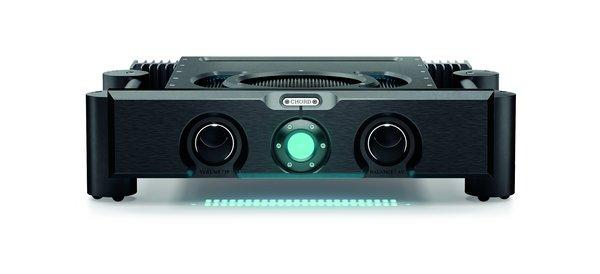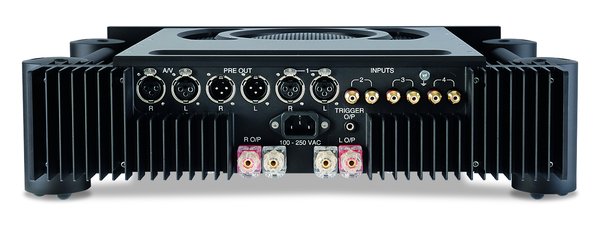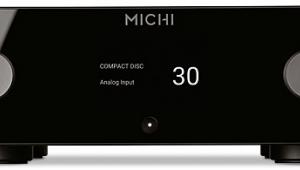Chord Ultima Integrated

 Chord's first new integrated amplifier in some seven years combines no fewer than four switchmode PSUs and 125W of stereo power into a very stylish Ultima 3 preamp chassis
Chord's first new integrated amplifier in some seven years combines no fewer than four switchmode PSUs and 125W of stereo power into a very stylish Ultima 3 preamp chassis
First seen in 2023 at Munich's High-End show, Chord Electronics' Ultima Integrated is steadily finding its way into selected hi-fi emporia. Based around John Franks' tried-and-tested amplifier architecture, it's the entry point to the Ultima family, whose rollout began with the flagship Ultima monoblocks .
Up to now, the Ultima range has consisted of preamplifiers and mighty power amps, catering to those building separates-based systems. It's desirable hardware, but hardly compact or readily affordable. Cue the £8500 Ultima Integrated, rated at 2x125W, and a concession to those with less room, tighter budgets or a preference for fewer boxes.
That said, like its larger brethren, the Ultima Integrated is a purely analogue affair - and a streamlined one at that. You'll still need to add source components to connect to its 'mere' four inputs, one of which is on balanced XLRs. There's no digital stage, which makes this model a successor to Chord Electronics' CPM 3350 rather than the CPM 2800 MKII (which had a DAC onboard).
 Inside the alloy casework, switchmode
PSUs [bottom] feed the line and ‘dual feedforward’
power stages [underneath]. The inputs
are all relay-switched [top] and the XLR input/
outputs are all buffered by dual op-amp stages
Inside the alloy casework, switchmode
PSUs [bottom] feed the line and ‘dual feedforward’
power stages [underneath]. The inputs
are all relay-switched [top] and the XLR input/
outputs are all buffered by dual op-amp stages
Wide Load
The Ultima Integrated is currently the only full-width integrated amplifier in this Kentish brand's line-up. The company has always had a penchant for smaller form factors, and this doesn't look likely to change judging by the new, paperback-sized Suzi pre and power models set to join its other oddly shaped amplifiers, like the Étude and Anni .
Aesthetically, Chord Electronics' original industrial design, after nearly 35 years, will be very familiar to many hi-fi enthusiasts. From the diminutive Mojo 2 to mid-sized units such as the Huei and Hugo M Scaler, to the Ultima powerhouses, there's no masking their shared DNA. Therefore, without diminishing the uniqueness of the brand's design, there's no surprises here - but no disappointments either.
Sum Of Its Parts
This new Chord model boasts a robust aluminium case, available in either a black or silver finish, and looks the part of an £8000+ amplifier. At first glance it appears a single, massive device, as if a CNC machine spent a week milling out the intricate form from a single block of aluminium. In reality it's more modular, with a 28mm-thick front fascia, and a rear panel with massive cooling fins, book-ending a smaller enclosure housing the Class AB amplifier stage and high-frequency, switchmode PSUs. As with previous generations of Chord products, the Ultima Integrated can be augmented with the company's Integra legs. These introduce some personalisation, as they can be bought in matching black or silver, or a striking nickel finish.
As a long-time user of Chord's Hugo 2 DAC/headphone amplifier , I wasn't surprised by the absence of an info display on the Ultima Integrated - or even meaningful labels telling you which input you've selected. The bulbous power button that lights up red (off) or blue (on), for example, is what you would expect from the manufacturer. This does mean you need to learn to 'decode' what a certain colour means, but that's more of an issue with Chord's range of DACs where multiple LED hues are deployed to indicate incoming sampling rates and selected filters.
Lighting The Way
On this analogue amplifier the only lighting you really need to interpret is a large, coloured ring circling the input selector, one of two hefty knobs on the symmetrically laid out fascia - the other offering balance control and access to an AV Bypass mode. You'll soon cotton on that red means input 1, yellow input 2, and so on. Alternatively, you can press the relevant button on the Ultima Integrated's sleekly styled metal remote. Whichever you prefer, changing an input produces a satisfying 'click' from the amp's microprocessor-controlled relays.
Complementing the front-panel illumination is a bank of LEDs inside the amp [see top-down shot, adjacent]. Viewed through the ventilation openings on the top panel, these are reminiscent of a high-end gaming PC equipped with an RGB-enhanced cooling system. If the built-in lighting becomes a bit much, a press of the Dim button on the handset will turn it off. And to be fair, it's only in a darkened setting that the illumination becomes noticeable from the listening position.
 Four line ins (three on RCAs, one balanced on XLRs) and AV bypass (direct to
power amp, on XLRs) are joined by pre outs (on XLRs) and 4mm speaker cable posts
Four line ins (three on RCAs, one balanced on XLRs) and AV bypass (direct to
power amp, on XLRs) are joined by pre outs (on XLRs) and 4mm speaker cable posts
Emotional Rescue
The Ultima Integrated promises to deliver much of the goodness of the high-end Ultima separates - and that's exactly what was on offer when connected to my Focal Sopra No2 floorstanders . Dispelling any chatter that switchmode PSU-based topologies are clinical or cold, Chord's amplifier showed itself capable of building and sustaining a dense wall of sound, presenting rich detail on a quiet background. There's a degree of warmth here to pull the right emotional strings, without losing sight of clarity or fine detail.
Fuse [Buzzin' Fly Records; 48kHz/24-bit] appeared last year as a triumphant and unexpected return of 1990s electropop duo Everything But The Girl after a twenty-year absence. Played on a Magnat MT-990 turntable with Pick it Pro cartridge, and using a NAD M66 purely as a phono preamp, Chord's integrated crafted an enveloping soundstage, built atop the album's often solid, slow beats that felt very intense and direct.
From a band never known for their upbeat songs, 'Lost', with its almost ambient soundscapes, is even more introspective than most. Yet together with the Focal floorstanders, the Ultima Integrated managed to extract plenty from this ostensibly minimalist recording. Tracey Thorn's vocals were delivered full-bodied and with a touch of warmth on a pitch-black stage, giving the lyrics a lot of impact; the three repetitions of 'I lost my mother' sounding especially poignant.
Driving Test
While the amp demonstrated that it's not 'afraid' of careful, nuanced compositions with this track, it was when I turned up the volume for 'Nothing To Lose' and 'Run A Red Light' that I got a strong indication of the power available from Chord's over-performing FET-based output stage. It subjectively encountered no problems driving my Sopra No2s' dual 180mm woofers.
Switching to an Eversolo DMP-A8 streamer/DAC connected over USB-B to T+A's DAC200 - and upsampling everything to DSD64 via Roon - the Ultima Integrated made hay of Departure Songs [Translation Lost Records; 44.1kHz/24-bit download] from Sydney-based prog-rock outfit We Lost The Sea. Similar to genre standards from Mogwai and Explosions From The Sky, this 2015 album is full of tracks that start off quietly and build up via intricate guitar arrangements before heading into meteoric finales, and the Chord amp effortlessly changed gear to follow the band's lead.
Even when cranking the volume, which the production and involving music of these instrumental tracks really encourages you to do, the Ultima Integrated kept producing a rich, detail-packed soundscape with a powerful, dynamic feel. As the near-12-minute piece 'Bogatyri' segued into a massive wall of overdriven guitars around the nine-minute mark, the amplifier seemed to be under no pressure at all.
Genre Jump
Hindi Zahra's 2012 debut Handmade [Blue Note 5099945725005] provides a delightful mix of musical styles, including jazz and bluegrass. 'Imik Si Mik' in particular is a memorable song, built on a catchy acoustic guitar riff that was delivered here with the sounds of sliding fingers and string 'twangs' on show. The fullness of Zahra's close-mic'd vocals, together with the definition given to the background rhythm section, made for an engrossing, intimate listen.
The next track, 'Stand Up', is quite a jump in genre, being a more layered affair containing multiple vocals and abrupt tempo changes. Again, the naturalistic sound of the acoustic guitar stood out, and I was impressed by the way the Ultima Integrated kept it together when Zahra leapt into a rapid solo on what - presumably - is an oud.
Bach In Business
Anyone wanting to dive into the repertoire of Carl Philipp Emanuel (aka C.P.E.) Bach, one of the sons of the more famous JS Bach, was gifted a fine opportunity this spring when Akademie für Alte Musik Berlin published Symphonies - From Berlin To Hamburg [Harmonia Mundi 3149020950463; 96kHz/24-bit], the last C.P.E. album in a series that began over two decades ago. Symphony for Strings and Continuo in G major parades the light-and-shade contrasts typical of these post-Baroque works, and Chord's amp deftly supported the mood shifts, going from delicate motifs to rousing set-pieces in a blink of the eye. Beneath the Ultima Integrated's flamboyant exterior is an amp of serious, down-to-earth talent!
Hi-Fi News Verdict
Brandishing the futuristic looks and a front-panel light show you've come to expect from Chord Electronics, the attractive Ultima Integrated offers ample power, but it's the combination of control, dynamic precision and a touch of warmth that makes this all-analogue amplifier an intriguing and distinct offering. There are more powerful and detailed sounding rivals out there, but few are as captivating.
Sound Quality: 86%

























































